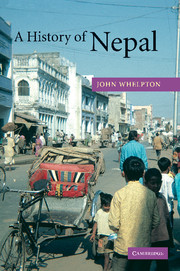Book contents
- Frontmatter
- Contents
- List of illustrations
- List of maps
- List of tables
- Key events
- Acknowledgements
- Notes on romanisation and terminology
- List of abbreviations
- Introduction
- 1 Environment, state and society in the central Himalayas to 1743
- 2 Unification and sanskritisation, 1743 – 1885
- 3 Nepal under the Shamsher Ranas, 1885 – 1951
- 4 The monarchy in ascendance: domestic politics and foreign relations, 1951 – 1991
- 5 The quest for ‘development’: economy and environment, 1951 – 1991
- 6 Lifestyles, values, identities: changes in Nepalese society, 1951 – 1991
- 7 Democracy and disillusionment: Nepal since 1991
- Genealogical tables
- Biographical notes
- Notes
- Glossary
- Bibliography
- Index
5 - The quest for ‘development’: economy and environment, 1951 – 1991
Published online by Cambridge University Press: 05 June 2016
- Frontmatter
- Contents
- List of illustrations
- List of maps
- List of tables
- Key events
- Acknowledgements
- Notes on romanisation and terminology
- List of abbreviations
- Introduction
- 1 Environment, state and society in the central Himalayas to 1743
- 2 Unification and sanskritisation, 1743 – 1885
- 3 Nepal under the Shamsher Ranas, 1885 – 1951
- 4 The monarchy in ascendance: domestic politics and foreign relations, 1951 – 1991
- 5 The quest for ‘development’: economy and environment, 1951 – 1991
- 6 Lifestyles, values, identities: changes in Nepalese society, 1951 – 1991
- 7 Democracy and disillusionment: Nepal since 1991
- Genealogical tables
- Biographical notes
- Notes
- Glossary
- Bibliography
- Index
Summary
POPULATION MOVEMENTS
Particularly in their final years, the Ranas had acknowledged an obligation to raise the living standards of the ordinary Nepalese people and, after 1951, this objective became central to the rhetoric of successive governments. The actual efforts made over the next forty years did have some success, particularly in raising life expectancy and the literacy rate. There were also real improvements in many villages, including the provision of running water and latrines. Most dramatically, there was a great expansion in the facilities available to residents of the Kathmandu Valley. To a large extent, however, all this was overshadowed by the relentless rise in population. This trend had already begun to emerge towards the end of the Rana years but now began to accelerate sharply. The 8.4 million Nepalese at the time of the 1954 census had become 18.5 million by 1991. By world standards, they were an overwhelmingly poor population and, because there had been no breakthrough in agricultural productivity, the rise in numbers threatened to make matters even worse. By the 1980s Nepal had turned from a net exporter to a net importer of food grains and the continuing fragmentation of holdings made it more and more difficult for ordinary peasant families to feed themselves. The result was rising indebtedness as well as an increase in temporary and permanent emigration. The fundamental problem was not only a growing shortage of cultivable land but also of easy access to the forests which were the source both of firewood and of fodder for livestock.
Conventional wisdom from the 1960s onwards saw the shrinking Himalayan forests as the cause of soil erosion, which in turn increased the silt load carried by rivers to the Gangetic plain and raised the danger of flooding. This ignored the fact that a high degree of soil erosion was normal in geologically young mountain ranges, even without any human habitation at all, and also that traditional terracing in the hills was often a more effective barrier against erosion than virgin forest. The extent of deforestation was also rather less than often supposed, and the prophecies of the country turning into a mountain desert by the end of the twentieth century proved unfounded.
- Type
- Chapter
- Information
- A History of Nepal , pp. 122 - 153Publisher: Cambridge University PressPrint publication year: 2005

